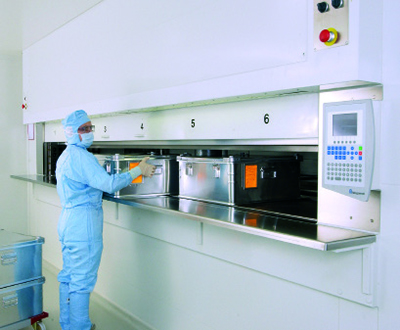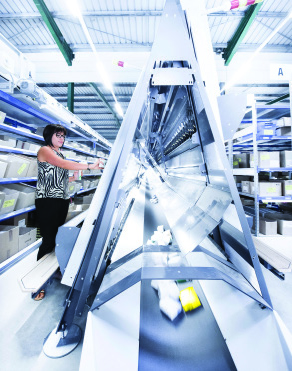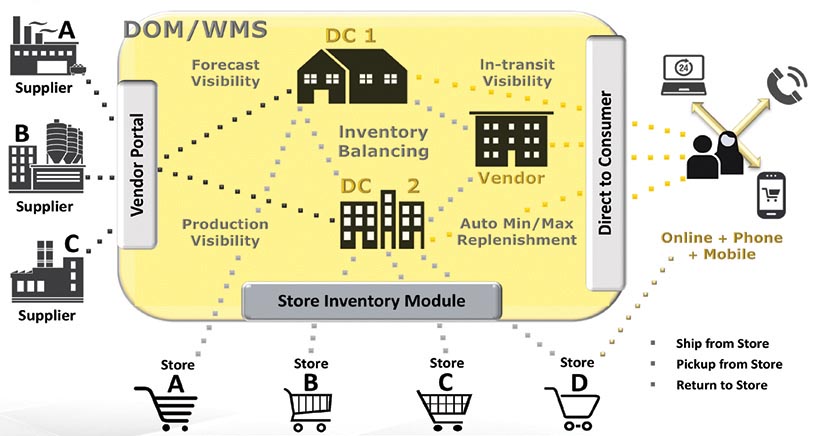Pharmaceutical Handling Adapts to DSCSA
As the complexities of the pharmaceutical supply chain continue to increase, new automation methods are being developed and implemented.

Like many other sectors, the pharmaceutical industry is constantly evolving—to the point where it can be challenging to keep track of all the changes, let alone manage them. Whether you’re adjusting to the new federal Drug Supply Chain Security Act (DSCSA) that impacts handling, labeling and data integration, or considering how to implement track and trace in the most cost-effective manner, your facility must be prepared for every possible scenario.
Although the complexity of the pharmaceutical supply chain is becoming more and more daunting with each passing day, a variety of solutions are available to help tackle the challenges. Automated storage and retrieval is providing some relief, while a novel software combination (distributed order management with a warehouse management system) is offering real-time track and trace.
Due to the continuous rise in regulations, particularly the DSCSA, every individual bottle or consumer box will eventually need to be individually serialized and made fully traceable throughout the entire supply chain—all the way to the point of dispense. As a mandatory federal law, rather than a Food and Drug Administration regulation, the act is unavoidable and, unlike FDA regulations that can be completely revised by the FDA alone, any major changes to the act beyond interpretation or adjustment of timelines (it currently has a multi-year roll-out) requires Congressional action.
“DSCSA offers the pharmaceutical industry a timetable for mandated compliance from the supplier through the distributor channel, initially at the lot/batch level, but continuing to full serialization as well,” says John Reichert, senior director of SCE solutions for Tecsys. “The later serialization requirements will put significant handling, labeling and data integration demands on the supply chain.”
Although the positive aspects of the act must not be understated—as it is designed to reduce drug counterfeiting and illegal moves outside of controlled supply chains—its impact on manufacturers and distributors should be carefully considered. After all, manufacturers’ responsibilities begin at the point of initial distribution and include accountability for documenting transactions and responding to inquiries on shipments. Distributors, on the other hand, are responsible for verifying the legitimacy of inbound receipts, subsequent de-aggregation events within their distribution centers and new aggregation events when they ship to customers.
 “The information passed to their customers requires a traceable history from its original transaction at the manufacturer to its current point in the supply chain,” Reichert explains. “Since the distributor is typically shipping in smaller units of measure and combining various manufacturers’ products into single shipments to customers, this becomes a complex data transaction. And, as future DSCSA dates add serialization at the bottle and case level, these transactions will become even more complex.”
“The information passed to their customers requires a traceable history from its original transaction at the manufacturer to its current point in the supply chain,” Reichert explains. “Since the distributor is typically shipping in smaller units of measure and combining various manufacturers’ products into single shipments to customers, this becomes a complex data transaction. And, as future DSCSA dates add serialization at the bottle and case level, these transactions will become even more complex.”
Aside from the DSCSA, regulations are also increasing outside of the United States. Much like the DSCSA and other U.S.-based regulations, they are also country specific, resulting in further complications for pharmaceutical supply chains on a global basis. The most noticeable complication may very well be compliance, as it varies from country to country.
“Compliance might require different processes, as well as information tracking and reporting, depending on what is transported to and from countries,” Reichert says. “To offer assistance, local 3PLs are beginning to step in, especially if they have the expertise required in a particular country. This is a trend I believe will only increase with time.”
Track and trace automation eliminates errors
In addition to individually serializing bottles and consumer boxes, the DSCSA also requires pharmaceutical manufacturers to provide serial numbers, lot numbers, batch numbers for cases and expiration dates that are readable by machines with 100% accuracy. This information, which is collected through scanning, must then be stored for six years, at minimum.

By taking restrictions like warehouse capacity and resource availability into consideration, DOM solutions optimally source operators’ orders and successfully orchestrate order fulfillment.
“Serialization, tracking and verification systems have to be put into place by November 2017,” says Ross Halket, executive director for ASD sales at SSI Schaefer. “By allowing wholesalers and pharmacies to track products, these measures not only guard against counterfeit medicine, but also provide tracing protocol requirements.”
To implement traceability, pharmaceutical wholesalers are currently encountering a variety of issues, from an increase in the costs of machines that trace information like ingredients and place of origin (and then record it), to a reduction in picking fulfillment rates, as each unit must be scanned individually. This process has become even more complicated as a result of current technology constraints when scanning GS1 codes, as each scan takes longer to complete per item, especially when compared to a RF scan of a 1D bar code. The packaging that wraps around the GS1 bar codes considerably reduces the speed of information collection.
However, some companies are now providing automated storage and retrieval solutions that significantly improve the scanning process and ensure 100% accuracy.
“Scanners that enable traceability down to the lot number have become a bit more difficult to implement, and order verifiers are even more uncommon,” Halket says. “But now that companies are providing both of these technologies, each order is picked, identified, counted and checked in a single step. Automation of this process saves on thousands in regards to manual labor, and it eliminates errors.”
 Although the DSCSA requires humans to read 2D DataMatrix bar codes, Halket predicts that more and more manufacturers and distributors will move toward automation, inspired by the 100% accuracy rate mandate that leaves them with no choice but to avoid human errors. To improve accuracy and lower manual labor costs—which often exceed pharmaceutical companies’ investment costs—Halket also believes GS1 scanners will eventually be improved so that the speed of each scan, along with throughput speed, increases substantially.
Although the DSCSA requires humans to read 2D DataMatrix bar codes, Halket predicts that more and more manufacturers and distributors will move toward automation, inspired by the 100% accuracy rate mandate that leaves them with no choice but to avoid human errors. To improve accuracy and lower manual labor costs—which often exceed pharmaceutical companies’ investment costs—Halket also believes GS1 scanners will eventually be improved so that the speed of each scan, along with throughput speed, increases substantially.
“New RFID devices will also be hitting the market soon, which will change everything concerning older methods of scanning technologies,” he adds. “Not to mention, materials handling companies are presently working with pharmaceutical manufacturers and wholesalers to adopt these new technologies and, of equal importance, become DSCSA compliant.”
DOM and WMS: A new combination for track and trace
As operators seek new methods to fill pharmaceutical orders as quickly and efficiently as possible, they are beginning to seek a new combination—a distributed order management (DOM) solution alongside a warehouse management system (WMS), which handles real-time track and trace and ensures products are distributed to the right place (and at the right time).
By taking restrictions like warehouse capacity and resource availability into consideration, DOM solutions optimally source operators’ orders and successfully orchestrate order fulfillment, according to Badri Devanathan, vice president of Softeon.
“Other constraints can be defined as well, leading to a reduction in transportation costs, shipments that are delivered on the dates promised, and the usage of appropriate packing containers and materials to ensure pharmaceutical drugs are usable—for example, cooler packs for certain drugs that are shipped to zip codes with unexpectedly high temperatures,” Devanathan adds.
In addition to order fulfillment and sourcing, the DOM/WMS combination is providing operators three other key solutions: seamless integration with pharmacy control systems so facilities can implement multiple automated and human-assisted dispensing strategies; National Drug Code Lot number tracking—from shipment to retrieval—so orders can be accurately identified during drug recalls; and the ability to handle the complexities of omni-channel fulfillment, as e-commerce sales continue to rise.
“Often, when DOM is implemented with individual warehouse management or fulfillment solutions, which are their own silos, the objectives aren’t fully met,” Devanathan says. “So some companies are now taking a platform approach, as they’re offering DOM, along with all planning and execution modules, on a single, Cloud-based platform that interacts with external systems like enterprise resource planning (ERP) systems, while also handling order fulfillment seamlessly.”
“The solution can also work on multiple technology platforms—hosted on-premise or in the Cloud—and can be deployed on different operating systems or databases, according to customer preferences and necessities,” he adds.
Out with the old, in with the new
In the past, operators used stand-alone software equipment. As islands of automation were implemented, operators would have to log out of one software system and then log into another.
But now operators within the pharmaceutical industry are linking equipment to their ERP, WMS and manufacturing software. In doing so, they are able to have one system in which they can enter all their information.
“That seamless connectivity, which has happened within the last five years in the pharmaceutical industry, is a big deal—the biggest trend that I’ve seen,” says Brian Baker, regional business director of new business for Kardex Remstar.
Aside from using a single system for data entry, companies are also focused on ergonomics and space savings, as floor space is crucial within the industry, which offers an extremely clean working environment. With this in mind, manufacturers and engineers, in particular, are responding by replacing old machines and technology with newer machines and technology.
“What we’re really doing is making machines that have more options,” Baker explains. “For example, in the past, we didn’t have cleanroom, refrigerated or frozen machines. Now we do, and they are becoming quite popular, as they require less manufacturing floor space and, in turn, cost less to use, when compared to older machines. The pharmaceutical industry always adapts to customers’ changing needs and requests—and will continue to do so.”

Article Topics
Latest in Logistics
Shipment and expenditure decreases trend down, notes Cass Freight Index March trucking tonnage trends down, reports ATA FTR Shippers Conditions Index enters negative territory DAT March Truckload Volume Index sees modest March gains National diesel average, for week of April 22, is down for the second straight week UPS reports first quarter earnings decline LM Podcast Series: Assessing the freight transportation and logistics markets with Tom Nightingale, AFS Logistics More LogisticsAbout the Author
Subscribe to Logistics Management Magazine

Find out what the world's most innovative companies are doing to improve productivity in their plants and distribution centers.
Start your FREE subscription today.
April 2023 Logistics Management

Latest Resources














